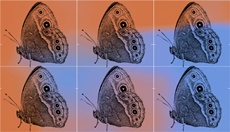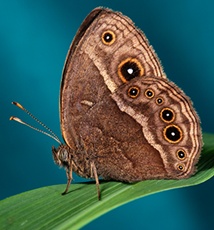Biomimicry enables researchers to change butterfly colours in six generations
18 Aug 2014
Yale University scientists have chosen the most fleeting of mediums for their groundbreaking work on biomimicry: They've changed the colour of butterfly wings.
 | |
| Illustration by Michael Helfenbein |
In so doing, they produced the first structural colour change in an animal by influencing evolution. The discovery may have implications for physicists and engineers trying to use evolutionary principles in the design of new materials and devices.
''What we did was to imagine a new target colour for the wings of a butterfly, without any knowledge of whether this colour was achievable, and selected for it gradually using populations of live butterflies,'' said Antónia Monteiro, a former professor of ecology and evolutionary biology at Yale, now at the National University of Singapore.
In this case, Monteiro and her team changed the wing colour of the butterfly Bicyclus anynana from brown to violet. They needed only six generations of selection.
Little is known about how structural colours in nature evolved, although researchers have studied such mechanisms extensively in recent years. Most attempts at biomimicry involve finding a desirable outcome in nature and simply trying to copy it in the laboratory.
 | |
| This image shows a male Bicyclus anynana, prior to the wing color change. (Photographs courtesy of Antónia Monteiro) |
Indeed, the scientists explained, natural selection algorithms can select for multiple characteristics simultaneously - which is standard operating procedure in the natural world.
The desired colour for the butterfly wings was achieved by changing the relative thickness of the wing scales - specifically, those of the lower lamina. It took less than a year of selective breeding to produce the color change from brown to violet.
 | |
| This image shows the color change from brown to violet, over six generations of breeding. (Photographs courtesy of Antónia Monteiro) |
''We just thought if natural selection has been able to modify wing colors in members of this genus of butterfly, perhaps so can we,'' Monteiro said.
In addition to Monteiro and Cao, other authors of the paper are former Yale postdoctoral research associate Bethany Wasik, who is now a postdoc at Cornell University; April Dinwiddie, a graduate student in Yale's Department of Ecology and Evolutionary Biology; Seng Fatt Liew, a graduate student in Yale's Department of Applied Physics; David Lilien, a physics undergraduate at Yale; and Heeso Noh, a former postdoc at Yale's Department of Applied Physics and currently an assistant professor at Kookmin University in South Korea.













.jpg)






.jpg)









